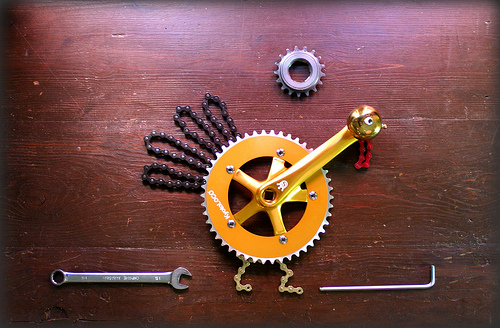
Don’t be a turkey and ignore these great rules from cycle-writer James Huang where he lays down the common sense “7 Rules For Staying Safe on the Roads.” Sure we know most of these smart thoughts, but it’s good to review and even better, if you have any kids or teens in your life who like to pedal it would be a wise move to ask them to read these with you. I remember when I was teaching my youngest daughter how to ride the streets we used to have this phrase called “corner boss.” What it meant was that upon those occasions when I called her the “corner boss,” she was the leader and responsible for making the decision when to cross at a busy corner. It was a fun way to give her the reigns. She liked it and made her feel responsible. Do you remember teaching your kids how to ride, and what do you remember most? You can let us know in the comments section.
From Journalist James Huang:
A recent study released by the NHTSA in the United States has confirmed cyclists’ worst fears: more of us really are getting hurt or killed out on the road than in years past. If you haven’t been involved yet in a car vs. bike incident yourself, chances are you know someone who has. You can’t completely control your surroundings but you can improve your odds.
I’m not going to profess to being a luminary in cycling safety. I haven’t studied it extensively, I haven’t interviewed any experts, and I haven’t conducted any big surveys on best practices. I can, however, share what’s worked for me for more than two decades.
1. Assume every driver is blind and stupid.
This isn’t true, of course, but it’s a mantra that has served me well, especially in this day and age where apparently no one can wait until they get home to update their damned Twitter feed. Once you operate under the assumption that a driver will neither see you nor do the right thing, I dare say you might see the world slightly differently.
To put it another way: pay attention and be hyper-aware of your surroundings. You can never have too much information about what traffic is doing around you. Watch the road ahead, scan side streets, and take mental notes on how many cars are approaching from behind. Prioritize safety over scenery and for god’s sake, ditch the earphones.
2. Be visible.
This isn’t just a matter of wearing bright clothing. While that is generally a smart thing to do, not all of us want to look like a rolling carton of rainbow sherbet all the time. Just as automobiles have adopted daytime running lights, I advocate the use of high-powered LED blinkers anytime you hit the road. This is a trend that I happily see growing amongst amateurs but it’s one that I first noticed with some professional riders, such as Colorado-based Lucas Euser from the UnitedHealthcare squad.
“I run a rear and front light in flashing mode all the time and that’s helped immensely,” he told BikeRadar. “I get made fun of a lot but I’ve had so many people stop the second they saw it, and you get more space from behind because you’ve got this big red flashing light.”
Keep in mind the emphasis on “high-powered”; basic models designed to lend a bit of nighttime visibility don’t put out enough light to be readily noticed in the middle of the day. There are plenty of good rechargeable models out there with lots of juice (one of my favorites is the Knog Blinder 4). Generally speaking, you can never have too many lumens. This is not a place to skimp.
3. Try to anticipate behavior.
Drivers may unfortunately use turn signals about as often as Tour de France racers use toe straps but as is often the case, body language often still gives away someone’s intentions. Whenever possible, look at the drivers of vehicles that are either approaching, have recently passed, or are stopped at a cross street. Where are their hands on the steering wheel? In which direction are they looking? If it’s a car that has just passed you, are they slowing down?
All of those bits of information can clue you in on what a driver is about to do. Also (see rule #1), never assume they’ll do what they’re supposed to do.
4. Establish eye contact.
Try to make eye contact with a driver whenever there’s even the slightest possibility of a direct collision. Even with bright clothing and flashers, there’s arguably no better indication that a driver actually sees you than when you lock eyes. Bear in mind that this still is no guarantee of safety – that driver might think they can beat you through the intersection, for example – but the lack of eye contact could provide that key warning that that person doesn’t know you’re there.
5. Take the road less traveled.
This applies to when as much as where. If possible, ride during off-peak hours and choose routes that are less likely to be main thoroughfares for motorized traffic. Dirt roads are a great example: they’re fun, they often see little traffic, and many of them are much smoother than you’d expect.
Basic laws of probability suggest that you’re less likely to be involved in a car-vs-bike incident if there are fewer vehicles on the road. Consider waking up a little earlier or taking a longer lunch break, for example, but keep in mind the angle of the rising (or setting) sun. Far too many drivers seem to cite glare on accident reports so keep that in mind depending on the time of day and the direction in which you’re traveling.
6. Be predictable.
When I was living in the US Midwest, there was a popular cycling club that would regularly gather up dozens of riders for weekend spins in the countryside. And unfortunately, their individual movements within the pack were about as predictable as lightning, scattered about the road like cookie crumbs that had fallen off the table and zigzagging about like water droplets on a hot frying pan.
Drivers can often get away with such erratic behavior, being safely cocooned in two-ton steel cages. You, on the other hand, have little more like a piece of Styrofoam and what would otherwise normally pass as underwear.
Being predictable does not mean religiously staying to the right (or left, depending on your region) of the white line at all times. It means being deliberate and smooth in your movements such that approaching traffic isn’t caught by surprise. Put yourself in the driver’s seat and think about what you look like in their eyes.
7. Be courteous.
I’m not saying cyclists should unquestionably defer to motorized vehicles when it comes to rules and regulations. That being said, drivers on the whole are angry enough with cyclists as it is so there’s no reason to further exacerbate the perception without good cause. Wanting to watch out for your own well-being is not the same as being a self-entitled jerk on the road. Social graces aside, being courteous to other road users requires awareness of the vehicles around you — a key element of staying safe on the road.






1 Comment
1. Assume every driver is blind and stupid. Or hates you cause you are on a bicycle.
There fixed it for ya